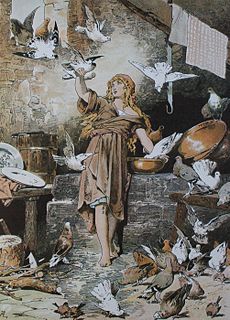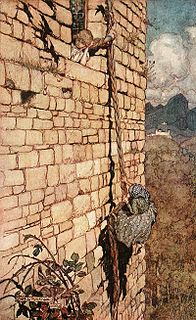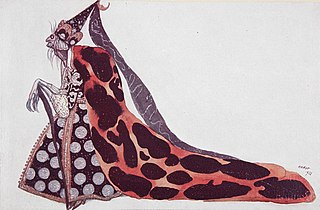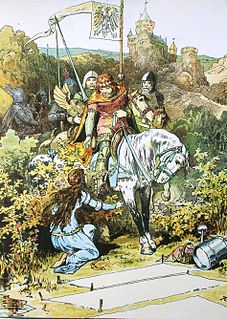See also
| Wikisource has original text related to this article: |
The Dove is an Italian literary fairy tale written by Giambattista Basile in his 1634 work, the Pentamerone . [1]
Although there is no evidence of direct influence, this tale combines many motifs in a manner similar to the Grimms' The Two Kings' Children . [2]
A poor old woman had to beg hard to get a pot full of beans. A prince and his friends rode by and broke the pot in a game. She cursed him to fall in love with an ogress's daughter. Within hours, he became lost in a wood and lost his attendants, and found a girl mocking snails. He fell in love at sight, and the girl, Filadoro, also fell in love with him. He was too tongue-tied to woo, and the ogress caught him. He tried to strike her, but could not move. She ordered him to dig an acre of land and sow it by evening. Filadoro comforted him. When he heard she had magic, he asked why they could not leave; she answered a conjunction of the stars prevented it, but would go. When the ogress returned in the evening, calling Filadoro to throw down her hair so that she could climb it, the land was ready. The next day, she set him to split seven stacks of wood, and Filadoro did it again.
The third day, the ogress suspected Filadoro and set the prince to empty a cistern. Filadoro said that they must flee and dug a hole to an underground passage and they ran away. The prince did not want to bring her to his palace afoot and dressed this way, so he went to get suitable clothing and a carriage. The ogress cursed him to forget her as soon as he was kissed, and when he reached the castle, his mother kissed him. He could no longer explain what had happened to him, and agreed to marry as his mother wished.
When Filadoro heard about the wedding, she disguised herself as a man and went to the castle where she was hired as a kitchen boy. When the pie which Filadoro had made is carved, out flies a dove who reminds the prince about everything Filadoro has done for him. Once the dove has flown away, the prince has the kitchen boy who made the pie brought before him. Filadoro falls before the prince's feet, he at once recognizes her and declares to his that she would be the one he would marry. His mother wants merely what the prince desires while the chosen bride admits to wanting to not be wed but return to Flanders. Whereupon, Filadoro and the prince are wed.
| Wikisource has original text related to this article: |

"Cinderella", or "The Little Glass Slipper", is a folk tale with thousands of variants throughout the world. The protagonist is a young woman living in forsaken circumstances that are suddenly changed to remarkable fortune, with her ascension to the throne via marriage. The story of Rhodopis, recounted by the Greek geographer Strabo sometime between around 7 BC and AD 23, about a Greek slave girl who marries the king of Egypt, is usually considered to be the earliest known variant of the Cinderella story.

Sleeping Beauty, or Little Briar Rose, also titled in English as The Sleeping Beauty in the Woods, is a classic fairy tale about a princess who is cursed to sleep for a hundred years by an evil fairy, to be awakened by a handsome prince at the end of them. The good fairy, realizing that the princess would be frightened if alone when she awakens, uses her wand to put every living person and animal in the palace asleep, to awaken when the princess does.

Giambattista Basile was an Italian poet, courtier, and fairy tale collector. His collections include the oldest recorded forms of many well-known European fairy tales. He is chiefly remembered for writing the collection of Neapolitan fairy tales known as Il Pentamerone.

The Pentamerone, subtitled Lo cunto de li cunti, is a seventeenth-century Neapolitan fairy tale collection by Italian poet and courtier Giambattista Basile.

"The Six Swans" is a German fairy tale collected by the Brothers Grimm in Grimm's Fairy Tales in 1812.
Snow-White-Fire-Red (Bianca-comu-nivi-russa-comu-focu) is a Sicilian fairy tale collected by Giuseppe Pitre and translated by Thomas Frederick Crane in Italian Popular Tales.

"Petrosinella" is a Neapolitan literary fairy tale, written by Giambattista Basile in his collection of fairy tales in 1634, Lo cunto de li cunti, or Pentamerone.
The Goat-faced Girl is an Italian fairy tale. Giambattista Basile included a version in his Pentamerone (1634-1636). Andrew Lang included a version, collected by Hermann Kletke, in The Grey Fairy Book (1900).
"The She-bear" is an Italian literary fairy tale, written by Giambattista Basile in his 1634 work, the Pentamerone.

The Wicked Fairy Godmother or the Wicked Fairy, a rare figure in fairy tales, is nevertheless among the best-known figures from such tales because of her appearance in one of the most widely known tales, Sleeping Beauty, and in the ballet derived from it. Anonymous in her first appearance, she was later named in some variants Carabosse and is called Maleficent in Walt Disney media.
"The Myrtle" is an Italian literary fairy tale written by Giambattista Basile in his 1634 work, the Pentamerone.

"The Three Sisters" or Green Meadow is an Italian literary fairy tale written by Giambattista Basile in his 1634 work, the Pentamerone.
Pintosmalto or Pinto Smauto is an Italian literary fairy tale written by Giambattista Basile in his 1634 work, the Pentamerone.
Penta of the Chopped-off Hands or The Girl With the Maimed Hands is an Italian literary fairy tale written by Giambattista Basile in his 1634 work, the Pentamerone.
The Young Slave is an Italian literary fairy tale written by Giambattista Basile in his 1634 work, the Pentamerone.
The Enchanted Snake or The Snake is an Italian fairy tale. Giambattista Basile wrote a variant in the Pentamerone. Andrew Lang drew upon this variant, for inclusion in The Green Fairy Book.
The Raven is an Italian literary fairy tale written by Giambattista Basile in his 1634 work, the Pentamerone. The story is a man winning a bride for his brother the king, and then having to protect the couple from perils that he can not tell anyone about, without being turned to stone.
The Three Crowns is an Italian literary fairy tale written by Giambattista Basile in his 1634 work, the Pentamerone.
The Dragon is an Italian literary fairy tale, included in Giambattista Basile's Pentamerone, first published 1635. In the English language, the tale was a selection in Thomas Keightley's Fairy Mythology (1828), and later appeared in John Edward Taylor 's translation of the entire work, The Pentamerone, or, The Story of Stories, Fun for the Little Ones (1848). The tale has been classed as a version of Aarne–Thompson type 462 "the outcast queens and the ogress queen", rather than as "the dragon-slayer". It exhibits folklore motif K873, "fatal deception by giving narcotic."
The Golden Root or The Golden Trunk is a literary fairy tale written by Giambattista Basile in the Pentamerone, as the fourth story of the fifth day.